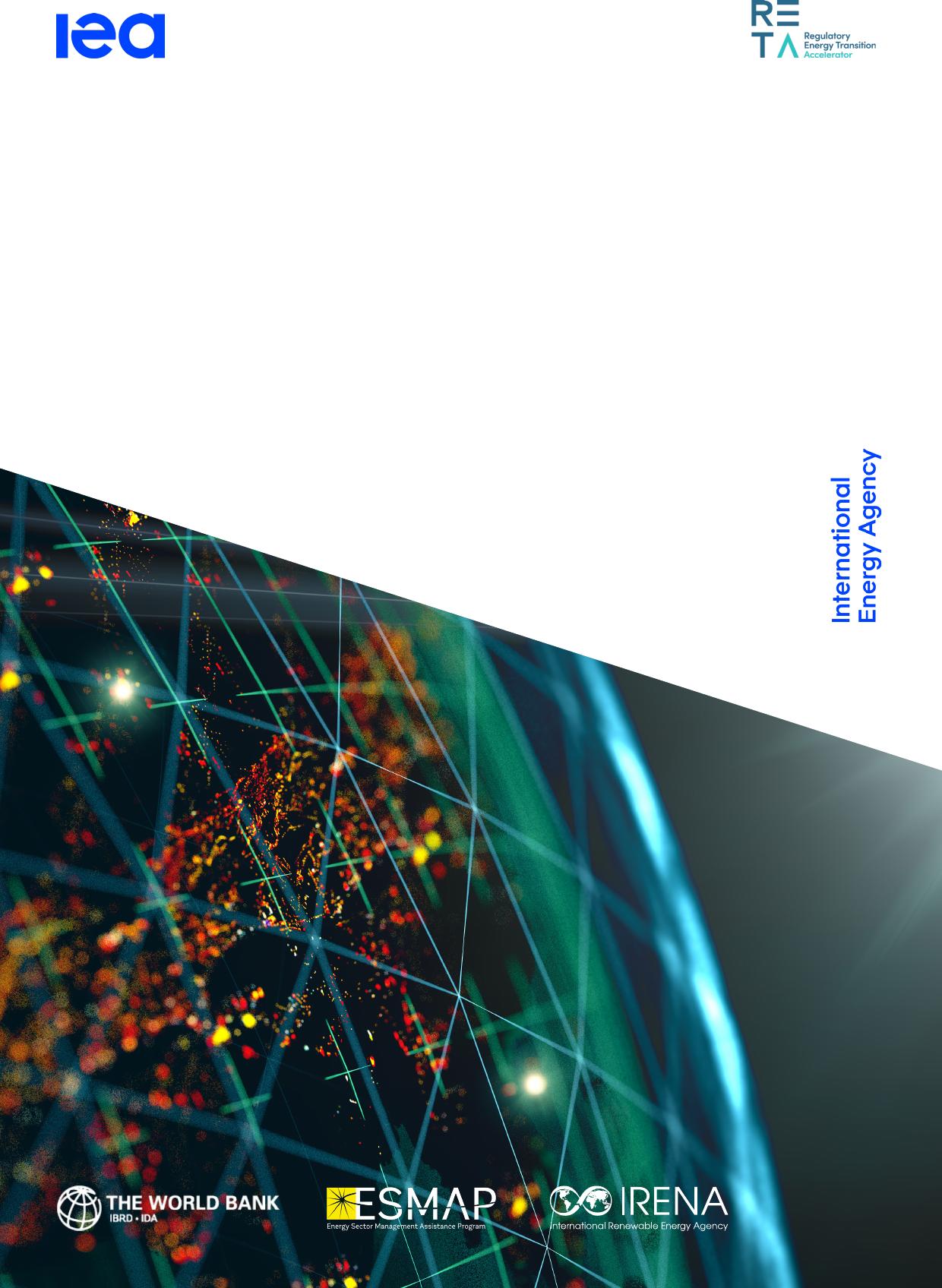InstitutionalArchitectureforRegionalPowerSystemIntegrationGovernment,UtilityandRegulatorRolesIncollaborationwithINTERNATIONALENERGYAGENCYTheIEAexaminestheIEAmemberIEAassociationfullspectrumcountries:countries:ofenergyissuesincludingoil,gasandAustraliaArgentinacoalsupplyandAustriaBrazildemand,renewableBelgiumChinaenergytechnologies,CanadaEgyptelectricitymarkets,CzechRepublicIndiaenergyefficiency,DenmarkIndonesiaaccesstoenergy,EstoniaKenyademandsideFinlandMoroccomanagementandFranceSenegalmuchmore.ThroughGermanySingaporeitswork,theIEAGreeceSouthAfricaadvocatespoliciesthatHungaryThailandwillenhancetheIrelandUkrainereliability,affordabilityItalyandsustainabilityofJapanenergyinitsKorea31membercountries,Lithuania13associationLuxembourgcountriesandbeyond.MexicoNetherlandsThispublicationandanyNewZealandmapincludedhereinareNorwaywithoutprejudicetothePolandstatusoforsovereigntyoverPortugalanyterritory,totheSlovakRepublicdelimitationofinternationalSpainfrontiersandboundariesandSwedentothenameofanyterritory,Switzerlandcityorarea.RepublicofTürkiyeUnitedKingdomUnitedStatesTheEuropeanCommissionalsoparticipatesintheworkoftheIEASource:IEA.InternationalEnergyAgencyWebsite:www.iea.orgInstitutionalArchitectureforRegionalPowerSystemIntegration:Government,UtilityandRegulatorrolesIEA.CCBY4.0.AbstractEstablishingappropriateinstitutionalarchitectureisimportanttointegratepowersystemsacrossbordersandfacilitateelectricitytrading,asevenifthenecessaryinfrastructureisinplace,itdoesnotautomaticallyfollowthatitisbeingusedtoexchangepowereffectively.Theco-ordinationofallstakeholders–governments,utilities1andregulators–isrequiredwithinjurisdictions,asisthecreationofregionalentitiestosupportandoverseetheintegrationprocess.Thisreportthereforeexaminesstakeholderrolesatdifferentstagesofcross-borderintegrationtoenablemultilateralpowertrade.Asenergyregulatorsareourmainaudience,wefocusontheirrolesandresponsibilitiesafterbrieflyaddressingthoseofgovernmentsandutilities.ThisdocumentwasdevelopedundertheRegulatoryEnergyTransitionAccelerator(RETA)initiative,whichaimstoenhancethecapacityofregulatorstoincreasethespeedofcleanenergytransitions.ItispartofaseriesofguidancenotespreparedbytheIEA,theWorldBank’sEnergySectorManagementAssistanceProgram(ESMAP)andIRENAtohelpkeystakeholdersnavigatethechallengesassociatedwithregionalpowersysteminterconnections,byprovidinganalyticaloutputsandexamplesofbestpracticesforregulatoryframeworksandmechanisms.Thesenotesfocusonthesoftinfrastructureofcross-borderpowerexchange,inaccordancewiththeprioritytopicsidentifiedthroughasurveyofregulatorsinFebruary-March2023.1Inthispaper,autilityisanyentitythatperformsactivitiesrelatedtoelectricitysupplyandsystemoperations,ineithertransmissionordistribution.Theseactivitiescanbecarriedoutbythesameentityinthecaseofverticallyintegratedutilitiesorseparatedinregionswheretheenergysectorisunbundled.PAGE1InstitutionalArchitectureforRegionalPowerSystemIntegration:Government,UtilityandRegulatorrolesIEA.CCBY4.0.IntroductionIntegratingpowersystemsattheregionalleveloffersmanybenefitsCross-borderintegrationofpowersystemshaslongbeenrecognisedasakeystrategytostrengthenelectricitysecurity,makeelectricitymoreaffordableandscaleupaccessto–andintegrationof–renewableenergyresources.Interconnectingpowersystemsmakesgenerationcapacityfromawidergeographicalareaavailabletomeetdemandandmaintainfrequency.Thisdecreasesdependencyonspecificgenerators,andcapacityreservescanpotentiallybeshared,boostingtheresilienceofthebroadersystem.Integratingpowersystemsalsoincreasessystemefficiencythrougheconomiesofscaleandpriceconvergence,andbyallowingexistinggenerationsourcestobeusedmoreefficiently.Providingjointaccesstoawiderrangeofelectricitygenerationresourcescanreducetotaloperatingcosts.InEurope,forexample,itisestimatedthatcross-borderelectricitytradedeliveredEUR34billionmoreinwelfarebenefitsin2021thanifnationalmarketshadbeenisolated.Finally,largerpowersystemscanintegrategreatervolumesofweather-dependantvariablerenewableenergybecausetheirwidergeographicalcoveragenaturallysmoothsthevariabilityoftheunderlyingresource.Thiscanalsoenablesupplydiversificationand,wherecomplementaryexists,allowrenewableenergysourcestobeusedmoreefficiently.Additionally,interconnectiongivespowerproducersaccesstoawiderrangeofcustomers,whichcanstrengtheninvestmentconfidenceandboosttheadoptionofrenewables.Thus,whencoupledwithdecarbonisationpolicies,interconnectioncanaccelerateCO2emissionsreductions.Establishingmultilateralpowertradingrequirespolitical,technicalandinstitutionalco-ordinationInrecognitionofthesebenefits,multiplejurisdictionsaroundtheworldhavebeenworkingtowardspowergridinterconnectionandmultilateralpowertrading.Inthisreport,jurisdictionalborderscanbeinternationalordomestic,andourassessmentofregionalintegrationincludescasesinAustralia,theUnitedStatesandCanada.Multilateralpowertradingrequirestheestablishmentofharmonisedrulesand/oragreementsamongmultiplejurisdictions,andinternationalexperiencehasshownthatacommonsetofpolitical,technicalandinstitutionalminimumrequirementsneedtobemet.PoliticalrequirementsencompassthecreationofpoliticalwillandPAGE2InstitutionalArchitectureforRegionalPowerSystemIntegration:Government,UtilityandRegulatorrolesintergovernmentalagreementsfromparticipatingcountries,whiletechnicalrequirementscoverrulesandregulationstoensuretheeffectiveoperationofcross-bordertrade.Forinstance,gridcodesmustbeharmonised,capacityallocationandcalculationmethodologiesdeveloped,anddatacollectionandinformation-sharingsystemsinstituted.Institutionalrequirementsrefertomultilateralpowertrademechanismssuchasdisputeresolutionandsettlements.Minimumrequirementsforestablishingmultilateralpowertrade•Politicalwill•Harmonisedtechnical•Co-ordinationoftradestandards(gridcodesarrangements•Intergovernmentalforinterconnectors)agreement(s)•Settlementand•Wheelingpaymentmechanism•CommonworkingmethodologylanguagePolitical•Third-partyaccessTechnicalagreementsInstitutional•Datacollectionandinformation-sharingsystems•InterconnectorcapacitycalculationmethodologyIEA.CCBY4.0.Source:IEA(2019),EstablishingMultilateralPowerTradeinASEAN.Theintegrationoftradingrulesandmechanismscanbedividedintothreelevels:early-stage,shallowanddeepharmonisation,dependingon:thelevelofinterconnectivitywithneighbouringcountriesthenatureandorganisationofpowertradingarrangementsthedegreeoftechnicalharmonisationofgridormarketoperationrules,gridcodes,tariffsanddatasharingthedegreeofco-ordinationinplanningandinvestmenttodevelopinfrastructuretheamountofinstitutionalarchitectureinplaceanditsenforcementpower.Identifyingthemaincharacteristicsofeachstageishelpfultounderstandthechangesandminimumrequirementsneededtotransitiontohigherlevelsofmarketintegration.PAGE3IEA.CCBY4.0.InstitutionalArchitectureforRegionalPowerSystemIntegration:Government,UtilityandRegulatorrolesCross-borderpowergridandmarketintegrationlevelsIntegrationlevelEarlystageShallowDeepInterconnectionBilateralpowertradestartsbetweentwoInterconnectedgridslinkseveralMostcountriesintheregionareinfrastructurecountries,withlimitedvolume.neighbouringcountries.interconnectedandparticipateintrade.Planning&investmentPlanninghappensatanationallevel,RegionalinterconnectionisfragmentedUseofregionalinfrastructureco-ordinationpossiblywithspecificregionalagreementsandoftenunderutilised.graduallyincreases.todeveloppriorityinfrastructure.NationalinvestmentsaresomewhatPlanningisoptimisedwitharegionalco-ordinatedwithanoptimisedperspective.HarmonisedmethodologiesTechnicalSimplerulesareagreeduponfortheregionalinvestmentplan.maybeusedfornational-levelplanning.harmonisationoperationoftheinterconnectedgrids.SomeharmonisationofregulatoryHarmonisedregulationsandtechnical&Commercialtrading&Long-termbilateralPPAspredominate.practicesandtechnical&marketrulesmarketrules,includinggridcodes,exist.marketdesignexists.(CommondataacquisitionandBilateralagreementsarepopular,withno(InteroperableandsimilardigitalInstitutionalstrongsupranationalentityinvolved.supervisionprotocolsareinplace.)technologiesandplatformsareinplace.)architectureGreaterMekongSubregionShort-termmarketsoftensupplementlong-Regionalmarketsarefullycompetitive,ExamplesLTMS-PIPtermPPAs.Transmissionpricingcost-reflectiveandoffervariousproducts.spreadscostsevenlyacrossallusers.Transmissionpricingevolvestobemoregranular.Regionalregulatorybodiesand/orsteeringcommitteesareinplacebutfaceEnforceabilityofregionalregulatorybodiesenforcementchallenges.and/orsteeringcommitteesisatanextendedlevel.SAPP,WAPP,EAPP,MEREUInternalMarket,WEIMIEA.CCBY4.0Notes:EAPP=EasternAfricaPowerPool.LTMS-PIP=LaoPDR-Thailand-Malaysia-SingaporePowerIntegrationProject.SAPP=SouthernAfricanPowerPool.WAPP=WesternAfricanPowerPool.WEIM=WesternEnergyImbalanceMarket(USA).Source:AdaptedfromWorldBank(forthcoming),BeyondBorders:PowerGridInterconnections&RegionalElectricityMarketsfortheSustainableEnergyTransition(workingpaper).PAGE4IEA.CCBY4.0.InstitutionalArchitectureforRegionalPowerSystemIntegration:Government,UtilityandRegulatorrolesKeymilestonesmarkthelengthyregionalpowersystemintegrationprocessItcantakealongtimeforafullyintegratedregionalelectricitymarkettomaterialise,usuallydecades,asexemplifiedbytheEUintegratedregionalelectricitymarket.Theprocesstypicallystartswithabilateralcross-borderelectricitytradearrangementbeforeanexplicitexpressionofinterestfromgovernmentsandutilitiesinmultilateralpowertrading,usuallyintheformofamemorandumofunderstanding(MoU),kicksoffaregionalmarketinitiative.Insomecases,theMoUalreadyspecifiesthecreationofinstitutionssuchasaregionalsystemoperatorandaregionalregulatoranddefinestheirrespectiveroles.Establishmentofaregionalregulator–orsometimesco-operationamongnationalregulators–canincitesubstantialprogressbycreatingconsensusontheoperationalaspectsofcross-bordertrade.Beyondthispoint,institutionalandorganisationalco-ordinationarecrucialforsuccessfulintegrationandoperation,withregionalstructuresbeinggrantedgreaterpower.Thisoftenleadstotheharmonisationofmarketrulesandregulationsattheregionallevel.Historicalmilestonesofselectedregionalpowersystemintegrationinitiatives16APG207MER507EAPP209WAPP397SAPP3060EU192019401960198020002020FirstbilateraltradeIntergovernmentalMoUEstablishmentofregionalregulatorIEA.CCBY4.0Notes:APG=ASEANPowerGrid.MER=MercadoEléctricoRegional.EAPP=EasternAfricaPowerPool.WAPP=WestAfricanPowerPool.SAPP=SouthernAfricanPowerPool.EU=EUInternalElectricityMarket.Achievingthesemilestonesandmeetingtherequirementsdescribedabovecallsfortheactiveparticipationofmultiplestakeholders–governments,utilitiesandregulators–acrossjurisdictionalboundariesbecause,inadditiontophysicalinterconnectors,consensusisneededonsystemoperationsandtherelatedPAGE5IEA.CCBY4.0.InstitutionalArchitectureforRegionalPowerSystemIntegration:Government,UtilityandRegulatorrolesIEA.CCBY4.0.regulations.Therefore,reachingadeeperlevelofintegrationisoftenaniterativeprocessinwhichstakeholderconsensusonchangesandtheirimplementationisgraduallyachieved.Regionalinstitutionstaskedwithimprovingandstrengtheningthesystemattheregionallevelmaythusbethebestplacedtoinstigatethesuccessivewavesofchangeinthisevolution.RoleofgovernmentsGovernmentsprovidethepoliticalimpulseforcross-borderpowersystemintegrationNational(orsupranational)governmentsprovidethelegalandpoliticalfoundationforinterconnectionprojects,withtheirpoliticalwillandleadershipsupportingtheearlystagesoftheprocess.IntergovernmentalagreementssuchasMoUsandjointstatements,whichsometimesencompassthecreationofregionalinstitutions,typicallyinitiatetheactionsneededtofulfilpoliticalrequirements.Likeanyothercross-borderactivity,interconnectorscannotbeconstructedoroperatedwithouttheconsensusofallparticipatingcountries.IntheASEANregion,memberstatessignedanintergovernmentalMoUin2007toestablishregionalpowertrade,followedbysubregionalagreementsforspecificinterconnectionprojects(e.g.theLTMS-PIPandtheBIMP-PIP).ASEANMemberStatesarecurrentlyintheprocessofextendingthisinitialMoUuntil2025.Similarly,theCentralAmericanElectricityMarketFrameworkTreaty,signedbytheregion’ssixnationalgovernmentsin1996,providedthepoliticalimpetustoformallycreatearegionalcompetitivepowermarket(MER),turningdecade-longfeasibilitystudiesandlocalpowertradingintoaco-ordinatedregionalpowerintegrationprocess.Insomeareas,dedicatedplatformsforgovernmentsfacilitatediplomaticeffortstoformulateconsensusamongcountriesinvolvedinregionalinterconnections.InAfrica,theRegionalEconomicCommunitiesprovideinstitutionalsupportformarketintegrationandacceleratethecreationofinternationalconsensus.In2006,theEconomicCommunityofWestAfricanStates(ECOWAS)tooktheleadincreatingtheWestAfricanPowerPool(WAPP).Twoyearslater,theECOWASRegionalElectricityRegulatoryAuthority(ERERA)wascreatedwithintheframeworkoftheECOWASEnergyProtocolandtheWAPPtoregulatecross-borderelectricityconnectionsandtrade,actingasacentralregulatoryentitywiththeauthoritytomakelegallybindingdecisions.InthecaseofCentralAmerica’sMER,theCentralAmericanIntegrationSystem(SICA)wascreatedin1993asaregionalandpoliticalorganisation.However,theroleofgovernmentsisnotonlytoforgeintergovernmentalagreements.Theyalsoendorseregional-levelregulationsoncross-bordertrade,PAGE6InstitutionalArchitectureforRegionalPowerSystemIntegration:Government,UtilityandRegulatorrolesIEA.CCBY4.0.standardsandmarketdesign(ifamarketisinplace).Forinstance,bothEUmemberstatesandtheEUParliamentwilldiscussandamendthecurrentEuropeanCommissionproposalforEUelectricitymarketreformtoreachaconsensus.Furthermore,whenregulationsareadopted,governmentsbeartheultimateresponsibilityforensuringthatregionalagreementsaretransposedintonationalregulations.Forexample,France’sgovernmentwasobligatedtoreviseitsnationalEnergyCodetoclarifytheroleoflocalregulatoryauthoritiesinlinewithrelevantEuropeandirectives.Apartfromlayingthelegalandinstitutionalfoundationforcross-borderinterconnectors,governmentscansupportintegrationprojectsbypromotingandsimplifyingtransmissioninvestments.Forinstance,everytwoyearstheEuropeanCommissionendorsesalistofProjectsofCommonInteresttosimplifyplanningandstreamlinepermit-grantingtofacilitatethecommissioningofcross-borderintegrationprojects.RoleofutilitiesElectricityutilitiesandpowersystemoperatorsarethedrivingforcebehindregional-leveltechnicalharmonisationAsutilitiesbearprimaryresponsibilityforconstructingandoperatingpowersystemstoensurethedeliveryofsecuresupplies,collaborationamongthemiscrucialtodevelopcross-borderinterconnections.Utilitiesdevelopinterconnectionsandassesstheirimpacts,sharetheirknowledgeofthesystemforregionalpowersystemplanning,andadjusttheirtechnicalstandardstoharmonisewithotherutilitiesintheregion.Theseactionsandrolessatisfythetechnicalrequirementsforcross-borderpowertrading.Effectiveco-ordinationisnecessarytoassesstheenergysecurityimpactsofinterconnectioninregionalpowersystemintegration.Typically,utilitiesassessimpactsonfrequencystability,violationofthermallimits,voltageprofilesandshort-circuitstrengths,althoughthemethodsandcriteriaadoptedvarybyutility.Assessmentfindingsdeterminethetechno-economicfeasibilityofaninterconnectionprojectandtechnologyselection,butmayalsoincitemodificationstonationalpowersystemplansoroperatingprocedures(procurementofreservesanddeterminationofthermallimits,gridcodes,communicationprotocols,etc).Asasecondstep,utilitiesmayalsoassessdispatchandmarket-clearingimpacts,astheinjectionorofftakeofpowerattheinterconnectormayaffectdomesticdynamics.Theresultsofthesevariousstudiesoftenshapethedesignofcross-bordertradeagreementsandrulesonhowinterconnectioncapacityisallocatedandused.PAGE7InstitutionalArchitectureforRegionalPowerSystemIntegration:Government,UtilityandRegulatorrolesIEA.CCBY4.0.Utilitiescanalsobeinvolvedinregionalpowersystemplanning,consideringtheirtoolsandknowledgeofthesystem.Thisworkmustbeperformedjointlywithplanningauthoritiestoensurethatenergyinfrastructuremeetsbothcross-sector(electricity,gas,transport,heating,climate,etc.)andregionalco-ordinationobjectives.Dependingonfinalregionalarrangements,utilitiesmayneedtoadjusttheirowngridcodes,operationalprocedures,databasestructures,communicationprotocolsandgridmodellingmethodologies.Toharmonisearrangementsamongdifferentutilities,workinggroupsandtaskforcesmadeupofrepresentativesofeachutility(andideallyoftheregulator)shouldbeconvened.Aregionalassociationofutilities,systemoperatorsandplanningco-ordinators,oranindependentsystemoperator,mayeventuallybeneededtoensureallworkstreamsareharmonisedandguidedbyasinglestrategicoutlook.Establishingsucharegionalinstitutionmakesiteasiertoaggregatelocalpowersystemdevelopmentplansintoaregionalproject.InEurope,theEuropeanNetworkofTransmissionSystemOperatorsforElectricity(ENTSO-E)isresponsiblefordraftingEurope-widedevelopmentplans,aprocessthatinvolvesallrelevantlocaltransmissionsystemoperators(TSOs).Meanwhile,theUnitedStatescurrentlyhassevenregionalandstateindependentsystemoperators(ISOs)andregionaltransmissionorganisations(RTOs)2tooverseeregionalplanning,pricingandwholesalepowermarkets.LocalutilitiesarepartoftheseRTOsandISOs.Similarly,theAssociationofPowerUtilitiesofAfrica(APUA)unitesAfricanpowerutilitiesandwasimportantinestablishingtheCentralAfricaPowerPoolin2003andtheEasternAfricaPowerPoolin2005.TheHeadsofASEANPowerUtilities/Authorities(HAPUA)inSoutheastAsiaandtheAssociationofMediterraneanTransmissionSystemOperators(Med-TSO)intheMediterraneanregionplaysimilarroles.RoleofregulatorsRegulatormandatesdifferregionallyandlocallyandcanevolveAlongwithgovernmentsandutilities,regulatorsarealsokeystakeholdersincross-borderpowermarketintegration.Theycanbeindependentorpartofthecentralgovernment,forinstancewithinadepartmentoftheministryinchargeof2TheCaliforniaIndependentSystemOperator(CAISO),MidcontinentIndependentSystemOperator(MISO),IndependentSystemOperatorNewEngland(ISO-NE),NewYorkIndependentSystemOperator(NYISO),PJMInterconnection,SouthwestPowerPool(SPP)andtheElectricReliabilityCouncilofTexas(ERCOT).PAGE8InstitutionalArchitectureforRegionalPowerSystemIntegration:Government,UtilityandRegulatorrolesIEA.CCBY4.0.energy.Wediscusstheroleofregulatorsindependentlyofgovernmentsbecauseregulatorybodieshavedistinctiveroles.Althoughthereisnosingleidealconfiguration,anumberoftheoreticalandempiricalargumentssupportthecreationofindependentregulatorstobenefitenergyconsumers.Manydeficienciescanbeattributedtoalackofregulatoryindependence,whichisapowersectorchallengealmostalldevelopingcountriesfaceaccordingtotheGlobalElectricityRegulatoryIndex.However,asestablishinganindependentinstitutionrequirestimeandresources,itissometimesnotthemosteffectivesolutionwhenquickactionisneeded.Globalexperiencehasshownthatsuccessfulregionalmarketintegrationinvolvesadoptingaregulatoryframeworktoenableco-ordinationamongnationalregulators,marketoperatorsandsystemoperators.Wherearegionalregulatoryentityhasbeendesignated,itisakeyinstitutionforcross-borderpowerexchangesbecauseitfacilitatesfulfilmentofthetechnicalandinstitutionalrequirements,withitsfunctionsgenerallycovering:Regulatoryoversightofregionalelectricityinfrastructuredevelopmentandpowergridplanning,byreviewing(throughtechnicalorplanningprocessreviews)andapprovingplansadvancedbytheregionalplanningentity.Harmonisationofinvestmentrecoverymethodologies(e.g.fortransmissioncostallocation,transmissionpricingandwheelingcharges)amonginterconnectedjurisdictions.Definitionandregulationoftheregionalmarketframework(e.g.tradingmechanismsandsettlements,marketrules).Monitoringofelectricitymarketsandmarketparticipantstoensuretransparency,compliancewithmarketregulationsandfaircompetition,andthedesignationofdisputeresolutionmethods(potentiallyalsoincludinganarbitrationroleforregulators).Aregulator’srolevariesdependingonwhetherpowersystemintegrationeffortsoccurwithintheregulator’sownjurisdictionorinvolvemultipleregulatedjurisdictions.Whenanoverarchingregulatoryentity(nationalorsupranational)coexistswithlocalregulators(subnationalornational),thelatterareoftentaskedwithsupportingtheregionalinterconnectioninitiativeby:Ensuringtheharmonisationoflocalruleswithregionalregulationsbyidentifyingpointsofconflict,makingamendmentswhenrequiredandevaluatingtheimpactofsuchamendments.Verifyingthatcost-benefitanalysesandplansofregionalregulatorsandutilitiesaresound,andapprovingtheoutcomeoftheseplans.Establishingandmaintainingdialoguewiththeotherlocalregulatorstoensurealignmentandthesharingofbestpractices.PAGE9InstitutionalArchitectureforRegionalPowerSystemIntegration:Government,UtilityandRegulatorrolesIEA.CCBY4.0.Creatingadedicateddepartmentorteamanddevelopingstaffexpertisetohandleinterconnectionmatters.Regionalpowersystemintegrationinitiativesaroundtheworlddemonstratethatthereismorethanonewaytodevelopregulatoryinstitutions.Whatmattersiswhetherthedifferentgovernmentsinvolvedhavegiventheregionalregulatorexplicitmandatesandsupport,recognisingitskeyroleinadvancingtheregionalintegrationinitiative.Moreover,itisimportantthattheregulator’smandatebeclearlydefinedandwellunderstoodbyallregionalmarketstakeholders.Rolesandresponsibilitiescanbesplitamongdifferentinstitutionsandevolveovertime.Atthelocalscale,theregulatoryentity’sfunctioncouldbefirstidentifiedaspartoftheministryinchargeofenergy,beforebeingspunoffasanindependentinstitution.Ascross-borderprojectsbecomemorecomplexandrequirespecificexpertise,adedicatedteamwithinthelocalauthoritycanbedesignated(e.g.aroundtenfull-timeemployeesworkontheseissuesatEnergyRegulatoryCommissioninFranceandOfgemintheUnitedKingdom).Inthisregard,itisalsoimportanttodesignaflexibleregulatoryframeworkthatcanbeadaptedtomarketevolutionandnewpolicyobjectivessuchasdecarbonisationtargets.EvolutionoftheroleofenergyregulatoryinstitutionsduringcleanenergytransitionsEnergyregulatorsaroundtheworldareactivelydiscussinghowtheirmandatesshouldevolvetoactondecarbonisation:InlinewiththeEuropeanCleanEnergyLawsof2019,thefirstarticleoftheregulationfortheAgencyfortheCooperationofEnergyRegulators(ACER)nowspecifiesthatACERshouldcontributetothe“consistent,efficientandeffectiveapplicationofUnionlawinordertoachievetheUnion'sclimateandenergygoals".TheUKgovernmentrecentlygrantedtheregulatorOfgema“statutorynetzeroduty”.AnamendmenttotheenergybillspecifiesOfgem’smandatetosupportthegovernment’snetzeroby2050obligationwhilefulfillingitsobjectiveofprotectingconsumerinterests.TheCanadaEnergyRegulator(CER)isguidedbymandatesfromtheMinistryofEnergyandNaturalResourcesofCanada(NRCAN),whichexpectstoputforwardanewsetofscenariostomodelapathtonetzeroemissions.ThisreinforcesCanada’scommitmenttoachievenetzeroemissionsby2050.PAGE10InstitutionalArchitectureforRegionalPowerSystemIntegration:Government,UtilityandRegulatorrolesDifferentregulatoryframeworksarepossibleatdifferentlevelsofregionalintegrationBasedontheIntroduction’sdefinitionofpowergridsandmarketintegration,werecognisefourlevelsofintegrationforregulatorsofcross-borderinterconnectors.Classificationisbasedonwhetherasupra-jurisdictionalregulatoryentityisinplace,whetherthisentityhasbindingpowers,andwhetherregulatoryentitiesatlocallevelsexistinparallelwiththecentralregulatoryentity.Theregulatoryentity’slevelofintegrationisnotnecessarilyrelatedtoregionalpowergridandmarketintegrationlevels,asthisdependsontheregulatorydesignagreeduponbyparticipatingjurisdictions.However,empiricalevidenceshowsthatthemostintegratedpowermarketstodayhaveallestablishedaregionalregulatoryinstitution,albeitwithstructuralvariability.Regulatorintegrationlevels,correspondingtoregionalpowergridsandmarketintegrationNEM(AER)RegulatorintegrationlevelUnifiedinstitutionWAPP(ERERA)WEIM(FERC)Centralbindingentity+MER(CRIE)EU(ACER)localregulatoryauthoritiesSAPP(RERA)Centralco-ordinatingentityEAPP(IRB)LTMS-PIPPAEM(regulatoryNocross-borderentityChina↔LaoPDRcommitteeyettobeestablished)India↔Nepal,Bhutan,BangladeshEarlystageShallowDeepPowergridandmarketintegrationlevelIEA.CCBY4.0Notes:LTMS-PIP=LaoPDR-Thailand-Malaysia-SingaporePowerIntegrationProject.WAPP=WestAfricanPowerPool.ERERA=ECOWASRegionalElectricityRegulatoryAuthority.MER=MercadoElectricoRegional.CRIE=ComisiónRegionaldeInterconexiónEléctrica.SAPP=SouthernAfricaPowerPool.RERA=RegionalEnergyRegulatorsAssociation.EAPP=EasternAfricaPowerPool.IRB=IndependentRegulatoryBoard.PAEM=Pan-ArabElectricityMarket.NEM=NationalElectricityMarketofAustralia.AER=AustralianEnergyRegulator.WEIM=WesternEnergyImbalanceMarket.ACER=AgencyfortheCooperationofEnergyRegulators.FERC=FederalEnergyRegulatoryCommission.Whenexistent,thenameoftheregionalregulatorybodyfollowsthatoftheregionalinterconnectioninitiative.AlthoughACERwasputinthisclassificationforreference,itisnotanactualregulatorasexplainedbelow.UnifiedinstitutionThemostcomprehensiveregulatoryintegrationisrealisedwhenasingle,unifiedinstitutionisresponsibleforregulatingregionalinterconnection.TheleadingexampleistheAustralianEnergyRegulator(AER),whichregulatestheNationalPAGE11IEA.CCBY4.0.InstitutionalArchitectureforRegionalPowerSystemIntegration:Government,UtilityandRegulatorrolesIEA.CCBY4.0.EnergyMarketinterconnectingfivejurisdictionsineasternandsouthernAustralia:Queensland,NewSouthWales(includingtheAustralianCapitalTerritory),SouthAustralia,VictoriaandTasmania.Createdin2005asanationalindependentbody,AERassumedtheresponsibilitiesofthepreviousregulatingbodiesacrossjurisdictionstoreducecomplexityandcutcompliancecostsfortheindustrysector.AER’scurrentmandateincludestheregulationofwholesaleandretailmarketsaswellastheoperationofelectricityandgasnetworks.Bycontrast,powersystemregulationinCanadahashistoricallybeendoneentirelyatthesubnationallevel,witheachprovinceretainingitsownenergyregulator.CreationoftheCanadaEnergyRegulator(CER)in2019–withamandatethatincludesoverseeinginterprovincialandinternationalpowerlines–aimedtomoderniseCanada’sregulatoryframeworkforenergyprojectsunderfederaljurisdiction,butithasnotledtoaunifiednationalregulatoryapproach(norwasitthepolicyintentbehindthecreationofCER).Asprovinceshavejurisdictionoverenergyandnaturalresourcesandgainrevenuesfromthem,grantingthefederalgovernmentgreaterpowerintheseareasisoftenperceivedasathreattoprovincialindependence.Alsoforsovereigntyreasons,itisdifficulttoimagineaunifiedcross-borderinstitutionoperatingwithoutnationalregulators,andinfactthissituationhasnotyetbeenobserved.CentralbindingentitywithlocalregulatoryauthoritiesAcommonconfigurationforregulatingregionalpowermarketsthatspanseveraljurisdictionsisaregionalregulatoryauthoritycoexistingwithlocalregulatoryauthorities(LRAs)responsiblefortheirownjurisdictions.Forintegratedmarkets,theoverarchingregionalinstitutionisoftengrantedbindingauthoritytoenforceregionalmarketrules.ComparingtheEuropeanUnionandUnitedStatesisinstructive,asbothhavehighlyintegratedformsofpowermarkets,albeitwithmajordifferencesintheirregulatoryframeworksandtheresponsibilitybalancebetweenlocalandcentralregulators.IntheEuropeanUnion,ACERisresponsibleforthecompletionofinternalelectricityandgasmarketsandco-ordinatestheworkofmembersstates’energyregulatorsoncross-borderinterconnectionissues.Asitsnamesuggests,ACER(theAgencyfortheCooperationofEnergyRegulators)isnotanactualEUregulatorandthebalancebetweenregionalandlocalregulationfavourslocal.LRAsretainresponsibilityovertheirnationaltransmissionanddistributionsystemsandwholesaleandretailpowermarkets,whileACERplaysacrucialroleinsupportingco-operationamongLRAsandcanstepintomakedecisionswhencountriescannotagree.PAGE12InstitutionalArchitectureforRegionalPowerSystemIntegration:Government,UtilityandRegulatorrolesAdifferentframeworkappliesintheUnitedStates,wheretheFederalEnergyRegulatoryCommission(FERC)actsasthesinglefederalregulatorandhasregulationauthorityovertheinterstatetransmissionsystemandinterstatewholesaleelectricitytransactions,whileLRAsatthestatelevelareresponsiblefordistributionsystemsandretailmarkets.However,FERCdoesnotregulatetheverticallyintegratedutilitiesthatownandoperatetransmission,distributionandgenerationinfrastructureinsomestates.DivisionofregulatoryauthorityintheUnitedStatesandtheEuropeanUnionUnitedStatesEuropeanUnionRoleofthecentralFERCACERregulatoryauthority•regulatesthetransmission•draftsframeworkguidelinesforsystemnetworkcodes•regulatesthewholesalemarket•imposescost-sharing•encouragesregionalarrangementsforcross-bordertransmissionlinesinlimitedcasescollaboration•resolvescross-borderregulatoryissuesRoleofthelocalStateregulatorsNationalregulatoryauthoritiesregulatoryauthority•regulatethedistributionsystem•regulatetransmissionand•regulatetheretailmarketdistributionsystems•regulatewholesaleandretailmarkets(incompliancewithEUlegislation)Source:IEA(2019),IntegratingPowerSystemsAcrossBorders.CentralAmerica’sMER(MercadoEléctricoRegional)withitsinterconnectorproject,theSIEPACline,isanotherinterestingexampleofapowersystemintegrationeffortsupportedbydesignatedregionalinstitutions.TheRegionalCommissiononElectricalInterconnection(CRIE)co-ordinatesthenationalregulatorsofthesixinterconnectedMERcountries(CostaRica,ElSalvador,Guatemala,Honduras,NicaraguaandPanama).ItregulatesMERtoensurefaircompetition,beingresponsibleforregulatingcommercialrelationsandforsettingtransmissionsystemtariffs,anditcanalsoapproveextensionstotheregionaltransmissionnetworkandintervenetosomeextentinthemarkettopreventabuses.Furthermore,itisinchargeofoverseeingsystemexchangesandverifyingthateachcountryhasenoughreservestocomplywithregionalperformanceindices.However,CRIE’slackofasoundregulatoryframeworkandenforcementrightshaveledtomistrustamongtheinterconnectedcountriesofMER.ThiswasoneofthereasonsforGuatemala’sdecisiontopulloutoftheregionalmarketin2021,adecisionthatcouldtakeyearstomaterialise.PAGE13IEA.CCBY4.0.InstitutionalArchitectureforRegionalPowerSystemIntegration:Government,UtilityandRegulatorrolesIEA.CCBY4.0.OntheAfricancontinent,theregionalWesternAfricanPowerPool(WAPP)markethasadoptedasimilargovernancestructure,havingdesignatedERERAastheregionalregulator.ERERAregulatescross-bordertrade,transmissiontariffsandbilateralcontractsintheregion,intervenesindisputesbetweenmarketparticipantsandhastheauthoritytoissuebindingregulationsformarketoperation.However,despitehavingaclearregulatorymandate,WAPPhasbeenveryslowtodevelopaunifiedregionalmarket,mainlyduetoalackofpoliticalconsensusamongparticipatingcountries.Forinstance,ERERAhaselaboratedasophisticatedregionalgridcode,butitisstillpendingapprovalatthecountrylevel.Centralco-ordinatingentityRegionalinterconnectedpowersystemscanalsoexistwithoutanyentitybeinggrantedthetraditionalmandateofaregionalregulator.Inthiscase,aregionalinstitutiongenerallyassumesaco-ordinatingroleamonglocalregulatorsratherthanexercisingbindingregulatoryauthorityintheregionalmarket.TheSouthernAfricanPowerMarket(SAPP)appliesthistypeofgovernanceframeworkandisoftenconsideredaself-regulatedmarket,astheregionalassociationRERAhasnopowertoestablishorenforceregulations.Participatingcountriesmustthereforeagreewithoneanotheronmarketandtransmissionrules,andRERA’smandateislimitedtofurtheringthedevelopmentofSAPPwhileencouragingregulatoryharmonisationandcapacitybuildinginitsmembercountries.AsSAPPiscurrentlyoneofthemostadvancedregionalpowermarketsinAfrica,thiscaseshowsthatmarketdevelopmentisnotproportionaltotheamountofpowergrantedtotheregionalinstitution.However,RERA’slackofauthorityhasgreatlylimitedSAPP’sharmonisationprocess,notablyintransmissionplanningandoperatingreserves.DiscussionsarecurrentlyunderwayonexpandingRERA’smandatetoincludemoreoftheresponsibilitiesexpectedfromaregionalregulator.RegionalplatformsforenergyregulatorsInitiativesandplatformsalsoexisttoco-ordinatetheworkofnationalenergyregulatorsinvolvedininterconnections,intheabsenceof(orinparallelwith)supra-jurisdictionalregulatorystructures.InEurope,theCouncilofEuropeanEnergyRegulators(CEER)facilitatesinformationexchangeandassistanceforLRAsandworkscloselywithACER.IntheASEANregion,althoughitsmandatecouldevolvewithrenewaloftheASEANPowerGrid(APG)MoU,AERN(theASEANEnergyRegulatoryNetwork)actsasaplatformforsharingbestpracticesonregulatoryissuesandnetworkingamongASEANcountries.InSouthAsia,regulatorforumssuchastheSouthAsiaForumforInfrastructureRegulation(SAFIR)andtheCouncilofExpertsofEnergyPAGE14InstitutionalArchitectureforRegionalPowerSystemIntegration:Government,UtilityandRegulatorrolesIEA.CCBY4.0.Regulators(CEERE)enablediscussiononissuessuchasgridcodesandcross-bordertradeoperationswithintheircorrespondingregionaleconomiccommunities.However,thesuccessofAERN,SAFIRandCEEREinharmonisingrulesandregulationsforpowertradingacrosstheirrespectiveinterconnectedcountrieshasprovenverylimitedsofar.ConclusionItisonlythroughtheparticipationandco-ordinationofallstakeholders,atboththenationalandregionallevels,thatthefullbenefitsofcross-borderpowertradingcanbeachieved.Severalenablingfactorsformthepreconditionsforsuccessfulregionalinterconnectioninitiatives:Strongpoliticalwilltoco-operate:Intergovernmentalagreementsandco-ordinatedpoliticalleadershiparenecessarytofacilitatestrongregionalintegration,forinstancethroughregionaleconomiccommunities.Soundcross-bordertradingrulesandtransmissionregulation:Utilitieshaveacrucialroleinensuringthatthetechnicalaspectsoftheserulesdonotcompromisethedeliveryofsecure,reliableandaffordableelectricitytoconsumers.Harmonisingtheserulescantakeseveraliterationstoprogressivelyreachhigherlevelsofintegration.Regionalinstitutionswithclearandsignificantexecutivepower:Often,regionalinstitutionaldesigntakeslongertoformulatethanthetechnicalaspectsofinterconnection(e.g.hardinfrastructure,gridcodes),asitcanbepolitical.Designingregionalinstitutionsfromthebeginningofaprojectenablesfasterimplementationofco-ordinatedaction.Theformat,rolesandresponsibilitiesofregionalinstitutions,aswellasregulatorydesign,canvaryfromoneregiontoanother,dependingonthepoliticalandphysicalcontext–numberandsizeofmembers,interconnectioncapacity,andpolicydecisionsregardingthedesiredlevelofcompetitionandopennesstoforeignparticipants.Theregionalregulatoryentityisparticularlyimportantinharmonisingrulesandoperationsattheregionallevel,whichinternationalexperiencedemonstratesasanecessarysteptowardshigherlevelsofmarketintegration.Finally,itiscrucialforregulatorstounderstandthedesiredlevelofregionalintegration,consideringpoliticalandculturalalignmentaswellasthetimerequiredtoachieveit.Studyingglobalexamplescangiveregulatorsinsightintotheeffortsnecessaryandhelpthemchoosethemostsuitablepathtoestablishregionalinstitutions.PAGE15InstitutionalArchitectureforRegionalPowerSystemIntegration:Government,UtilityandRegulatorrolesAbbreviationsandacronymsACERAgencyfortheCooperationofEnergyRegulatorsAERAustralianEnergyRegulatorAERNASEANEnergyRegulatoryNetworkAPGASEANPowerGridAPUAAssociationofPowerUtilitiesofAfricaBIMP-PIPBruneiDarussalam,Indonesia,MalaysiaandthePhilippinesPowerIntegrationProjectCEERCouncilofEuropeanEnergyRegulatorsCEERECouncilofExpertsofEnergyRegulatorsCERCanadaEnergyRegulatorCRECommissionderégulationdel'énergie(EnergyRegulatoryCommission)CRIEComisiónRegionaldeInterconexiónEléctricaEAPPEasternAfricaPowerPoolECOWASEconomicCommunityofWestAfricanStatesERERAECOWASRegionalElectricityRegulatoryAuthorityESMAPEnergySectorManagementAssistanceProgramFERCFederalEnergyRegulatoryCommissionHAPUAHeadsofASEANPowerUtilities/AuthoritiesISOIndependentsystemoperatorsLRALocalregulatoryauthoritiesLTMS-PIPLaoPDR-Thailand-Malaysia-SingaporePowerIntegrationProjectMERMercadoEléctricoRegionalMoUMemorandumofunderstandingNEMNationalElectricityMarketofAustraliaNRCANNaturalResourcesofCanadaRETARegulatoryEnergyTransitionAcceleratorRTORegionaltransmissionorganisationsSAFIRSouthAsiaForumforInfrastructureRegulationSAPPSouthernAfricanPowerTSOTransmissionsystemoperatorsWAPPWestAfricanPowerPoolPAGE16IEA.CCBY4.0.InternationalEnergyAgency(IEA).ThisworkreflectstheviewsoftheIEASecretariatbutdoesnotnecessarilyreflectthoseoftheIEA’sindividualmembercountriesorofanyparticularfunderorcollaborator.Theworkdoesnotconstituteprofessionaladviceonanyspecificissueorsituation.NeithertheIEAnoranyothercontributortothisworkmakesanyrepresentationorwarranty,expressorimplied,inrespectofthework’scontents(includingitscompletenessoraccuracy)andshallnotberesponsibleforanyuseof,orrelianceon,thework.SubjecttotheIEA’sNoticeforCC-licencedContent,thisworkislicencedunderaCreativeCommonsAttribution4.0InternationalLicence.Thisdocumentandanymapincludedhereinarewithoutprejudicetothestatusoforsovereigntyoveranyterritory,tothedelimitationofinternationalfrontiersandboundariesandtothenameofanyterritory,cityorarea.Unlessotherwiseindicated,allmaterialpresentedinfiguresandtablesisderivedfromIEAdataandanalysis.IEAPublicationsInternationalEnergyAgencyWebsite:www.iea.orgContactinformation:www.iea.org/contactTypesetinFrancebyIEA-November2023Coverdesign:IEAPhotocredits:©ShutterStock



 VIP
VIP VIP
VIP VIP
VIP VIP
VIP VIP
VIP VIP
VIP VIP
VIP VIP
VIP VIP
VIP VIP
VIP